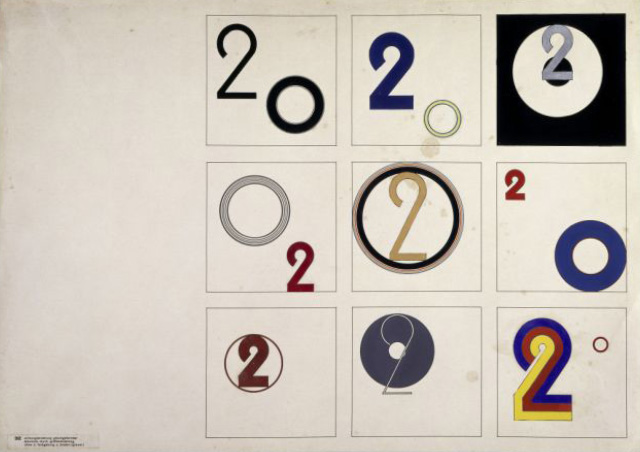Change of effect due to change of size
Friedrich Reimann, 1932
Friedrich Reimann’s variation of the numeral 2 was his solution to one of 52 assignments that Joost Schmidt developed around 1930 for his class in the advertising department.

[Translate to English:] text
Friedrich Reimann came to the Bauhaus Dessau in the summer of 1931 and, after attending the preliminary course, began his training in the printing and advertising workshop under Joost Schmidt, who had taken over direction of the workshop when Herbert Bayer departed in 1928 and subsequently began to develop a systematic programme of instruction. This included a series of 52 assignments, for which, at the beginning of the course, Schmidt “specified basic geometric shapes, and later newspaper clippings such as patterns and images, which were to be arranged in relation to area or size, to colour or to the material, and above all: were to be contrasted with one another” (Brüning 1995, p. 217). The students were tasked with developing different solutions for the various assignments. These were juxtaposed in equally sized fields, usually on a single sheet of drawing paper, and were thus mutually comparable in terms of their varied effects.
In the solution to assignment no. 32 depicted here, the numeral 2 was a given. Within the nine square drawing fields, Reimann varied the numeral in terms of size, position, shape and colour, and placed it in relation to a second element, a circle. The juxtaposition of Reimann’s nine variants for this task make it possible to directly compare how both elements are read together or separately, how they merge into each other, or how one element recedes in perception behind the other.
For the book “bauhauskommunikation” (Rössler 2009), which appeared as volume 1 in the New Bauhaus Books series, Ute Brüning compiled a collection of the 52 assignments from Joost Schmidt’s advertising class. There, the sheets with the students’ solutions – many of them by Friedrich Reimann – are presented alongside Joost Schmidt’s assignments and task statements. During his tenure, Schmidt continually revised and adapted the assignments for his class. When the Bauhaus relocated to Berlin at the end of 1932, Joost Schmidt was no longer among the teachers who continued to teach there in those last months before the closure of the Bauhaus. Friedrich Reimann continued his studies in Berlin and, on 1 April 1933, was awarded Bauhaus Diploma No. 117 by the advertising department – just days before the Gestapo raided and sealed the Bauhaus in Berlin.
[NO 2018; Translation: DK]
- Literature:
- Brüning, Ute (2009): Joost Schmidt: ein Curriculum für Werbegrafiker, in: Rössler, Patrick (Hg.): bauhaus kommunikation. Innovative Strategien im Umgang mit Medien, interner und externer Öffentlichkeit, Neue Bauhausbücher, neue Zählung Band 1, hrsg. vom Bauhaus-Archiv Berlin, Berlin.
- Brüning, Ute / Bauhaus-Archiv Berlin (Hg., 1995): Das A und O des Bauhauses, Bauhauswerbung: Schriftbilder, Drucksachen, Ausstellungsdesign, Leipzig.
- Marzona, Egidio und Fricke, Marion (Hg., 1984): Joost Schmidt. Lehre und Arbeit am Bauhaus 1919–32, Edition Marzona, Düsseldorf.